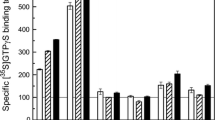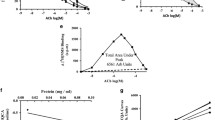Abstract
Accumulating studies have implicated intracellular signaling through muscarinic acetylcholine receptors (mAChRs) in psychiatric illness. In the present study, carbamylcholine chloride (carbachol)-induced Gαi/o and Gαq/11 activation was identified in postmortem human prefrontal cortical membranes. The following two sample cohorts were used: subjects [1], consisting of 40 controls without neuropsychiatric disorders, and subjects [2], consisting of 20 with bipolar disorder (BP), 20 major depressive disorder (MDD), 20 schizophrenia, and 20 controls, strictly sex- and age-matched. Carbachol-stimulated [35S]GTPγS binding to human brain membranes was assessed by the two methods, i.e., conventional method using filtration techniques (Gαi/o activation coupled to M2/M4 mAChRs) applied to subjects [1], and [35S]GTPγS binding/immuno precipitation assay (Gαq/11 activation coupled to M1 mAChR) applied to subjects [1] and [2]. The concentration eliciting the half-maximal effect (EC50), maximum percent increase (%Emax), and slope factor were obtained from concentration–response curve of carbachol-induced Gαi/o and Gαq/11 activation. The pEC50 values of both carbachol-induced Gαi/o and Gαq/11 activations in subjects [1] were significantly correlated, though its implications or underlying molecular processes are unclear. The results of M1 mAChR-mediated Gαq/11 activation in subjects [2] indicated no significant disorder-specific alterations. However, the distribution patterns of the pEC50 values showed unequal variances among the groups. There was a significant inverse correlation between the %Emax values and the pEC50 values in subjects with schizophrenia, but not in those with BP or MDD, or controls. These data support the notion that schizophrenia patients consist of biologically heterogeneous subgroups with respect to M1 mAChR-mediated signaling pathways.





Similar content being viewed by others
References
Caulfield MP, Birdsall NJM (1998) International union of pharmacology. XVII. Classification of muscarinic acetylcholine receptors. Pharmacol Rev 50:279–290
Eglen RM (2005) Muscarinic receptor subtype pharmacology and physiology. Prog Med Chem 43:105–136. https://doi.org/10.1016/S0079-6468(05)43004-0
Felder CC (1995) Muscarinic acetylcholine receptors: signal transduction through multiple effectors. FASEB J 9:619–625
Scarr E (2012) Muscarinic receptors: their roles in disorders of the central nervous system and potential as therapeutic targets. CNS Neurosci Ther 18:369–379. https://doi.org/10.1111/j.1755-5949.2011.00249.x
Readler TJ, Bymaster FP, Tandon R, Copolov D, Dean B (2007) Towards a muscarinic hypothesis of schizophrenia. Mol Psychiatry 12:232–246. https://doi.org/10.1038/sj.mp.4001924
Bymaster FP, McKinzie DL, Felder CC, Wess J (2003) Use of M1–M5 muscarinic receptor knockout mice as novel tools to delineate the physiological roles of the muscarinic cholinergic system. Neurochem Res 28:437–442
Jeon WJ, Dean B, Scarr E, Gibbons A (2015) The role of muscarinic receptors in the pathophysiology of mood disorders: a potential novel treatment? Curr Neuropharmacol 13:739–749
Scarr E (2009) Muscarinic receptors in psychiatric disorders––can we mimic 'health'? Neurosignals 17:298–310. https://doi.org/10.1159/000231896
Bennett JP Jr, Enna SJ, Bylund DB, Gillin JC, Wyatt RJ, Snyder SH (1979) Neurotransmitter receptors in frontal cortex of schizophrenics. Arch Gen Psychiatry 36:927–934
Toru M, Watanabe S, Shibuya H, Nishikawa T, Noda K, Mitsushio H, Ichikawa H, Kunugi A, Takashima M, Mataga N, Ogawa A (1988) Neurotransmitters, receptors and neuropeptides in post-mortem brains of chronic schizophrenic patients. Acta Psychiatr Scand 78:121–137
Watanabe S, Nishikawa T, Takashima M, Toru M (1983) Increased muscarinic cholinergic receptors in prefrontal cortices of medicated schizophrenics. Life Sci 33:2187–2196
Crook JM, Tomaskovic-Crook E, Copolov DL, Dean B (2000) Decreased muscarinic receptor binding in subjects with schizophrenia: a study of the human hippocampal formation. Biol Psychiatry 48:381–388
Crook JM, Tomaskovic-Crook E, Copolov DL, Dean B (2001) Low muscarinic receptor binding in prefrontal cortex from subjects with schizophrenia: a study of Brodmann’s areas 8, 9, 10, and 46 and the effects of neuroleptic drug treatment. Am J Psychiatry 158:918–925. https://doi.org/10.1176/appi.ajp.158.6.918
Dean B, Crook JM, Opeskin K, Hill C, Keks N, Copolov DL (1996) The density of muscarinic M1 receptors is decreased in the caudate-putamen of subjects with schizophrenia. Mol Psychiatry 1:54–58
Dean B, McLeod M, Keriakous D, McKenzie J, Scarr E (2002) Decreased muscarinic1 receptors in the dorsolateral prefrontal cortex of subjects with schizophrenia. Mol Psychiatry 7:1083–1091
Deng C, Huang XF (2005) Decreased density of muscarinic receptors in the superior temporal gyrus in schizophrenia. J Neurosci Res 15:883–890. https://doi.org/10.1002/jnr.20600
Gibbons AS, Scarr E, McLean C, Sundram S, Dean B (2009) Decreased muscarinic receptor binding in the frontal cortex of bipolar disorder and major depressive disorder subjects. J Affect Disord 116:184–191. https://doi.org/10.1016/j.jad.2008.11.015
Gibbons AS, Scarr E, Boer S, Money T, Jeon WJ, Felder C, Dean B (2013) Widespread decreases in cortical muscarinic receptors in a subset of people with schizophrenia. Int J Neuropsychopharmacol 16:37–46. https://doi.org/10.1017/S1461145712000028
Scarr E, Sundram S, Keriakous D, Dean B (2007) Altered hippocampal muscarinic M4, but not M1, receptor expression from subjects with schizophrenia. Biol Psychiatry 61:1161–1170. https://doi.org/10.1016/j.biopsych.2006.08.050
Scarr E, Cowie TF, Kanellakis S, Sundram S, Pantelis C, Dean B (2009) Decreased cortical muscarinic receptor define a subgroup of subjects with schizophrenia. Mol Psychiatry 14:1017–1023. https://doi.org/10.1038/mp.2008.28
Zavitsanou K, Katsifis A, Mattner F, Huang XF (2004) Investigation of M1/M4 muscarinic receptors in the anterior cingulate cortex in schizophrenia, bipolar disorder, and major depression disorder. Neuropsychopharmacology 29:619–625. https://doi.org/10.1038/sj.npp.1300367
Crook JM, Dean B, Pavey G, Copolov D (1999) The binding of [3H]AF-DX 384 is reduced in the caudate-putamen of subjects with schizophrenia. Life Sci. 64:1761–1771
Gibbons AS, Jeon WJ, Scarr E, Dean B (2016) Changes in muscarinic M2 receptor levels in the cortex of subjects with bipolar disorder and major depressive disorder and in rats after treatment with mood stabilizers and antidepressants. Int J Neuropsychopharmacol 19:118. https://doi.org/10.1093/ijnp/pyv118
Zavitsanou K, Katsifis A, Yu Y, Huang XF (2005) M2/M4 muscarinic receptor binding in the anterior cingulate cortex in schizophrenia and mood disorders. Brain Res Bull 65:397–403. https://doi.org/10.1016/j.brainresbull.2005.02.007
Jeon WJ, Gibbons AS, Dean B (2013) The use of a modified [3H]4-DAMP radioligand binding assay with increased selectivity for muscarinic M3 receptor shows that cortical CHRM3 levels are not altered in mood disorders. Prog Neuropsychopharmacol Biol Psychiatry 47:7–12. https://doi.org/10.1016/j.pnpbp.2013.08.001
Salah-Uddin H, Scarr E, Pavey G, Harris K, Hagan JJ, Dean B, Challiss RA, Watson JM (2009) Altered M1 muscarinic acetylcholine receptor (CHRM1)-Gαq/11 coupling in a schizophrenia endophenotype. Neuropsychopharmacology 34:2156–2166. https://doi.org/10.1038/npp.2009.41
Salah-Uddin H, Thomas DR, Davies CH, Hagan JJ, Wood MD, Watson JM, Challiss RA (2008) Pharmacological assessment of M1 muscarinic acetylcholine receptor-Gq/11 protein coupling in membranes prepared from postmortem human brain tissue. J Pharmacol Exp Ther 325:869–874. https://doi.org/10.1124/jpet.108.137968
Odagaki Y, Kinoshita M, Ota T, Meana JJ, Callado LF, García-Sevilla JA (2017) Functional activation of Gαq coupled to 5-HT2A receptor and M1 muscarinic acetylcholine receptor in postmortem human cortical membranes. J Neural Transm 124:1123–1133. https://doi.org/10.1007/s00702-017-1749-0
Odagaki Y (2019) Guanosine-5′-O-(3-[35S]thio)triphosphate ([35S]GTPγS) binding/immunoprecipitation assay using magnetic beads coated with anti-Gα antibody in mammalian brain membranes. In: Odagaki Y, Borroto-Escuela DO (eds) Co-immunoprecipitation methods for brain tissue neuromethods, vol 144. Springer Nature, New York, pp 97–108
Odagaki Y, Kinoshita M, Ota T, Meana JJ, Callado LF, García-Sevilla JA (2015) Adenosine A1 receptors are selectively coupled to Gαi-3 in postmortem human brain cortex: guanosine-5′-O-(3-[35S]thio)triphosphate ([35S]GTPγS) binding/immunoprecipitation study. Eur J Pharmacol 764:592–598. https://doi.org/10.1016/j.ejphar.2015.07.049
Odagaki Y, Kinoshita M, Ota T, Meana JJ, Callado LF, García-Sevilla JA (2019) Optimization and pharmacological characterization of receptor-mediated Gi/o activation in postmortem human prefrontal cortex. Basic Clin Pharmacol Toxicol 124:649–659. https://doi.org/10.1111/bcpt.13183
Bowie CR, Harvey PD (2006) Cognitive deficits and functional outcome in schizophrenia. Neuropsychiatr Dis Treat 2:531–536
Tripathi A, Kar SK, Shukla R (2018) Cognitive deficits in schizophrenia: understanding the biological correlates and remediation strategies. Clin Psychopharmacol Neurosci 16:7–17. https://doi.org/10.9758/cpn.2018.16.1.7
MacQueen GM, Memedovich KA (2017) Cognitive dysfunction in major depression and bipolar disorder: assessment and treatment options. Psychiatry Clin Neurosci 71:18–27. https://doi.org/10.1111/pcn.12463
Levey AI, Kitt CA, Simonds WF, Price DL, Brann MR (1991) Identification and localization of muscarinic acetylcholine receptor proteins in brain with subtype-specific antibodies. J Neurosci 11:3218–3226
Levey AI, Edmunds SM, Heilman CJ, Desmond TJ, Frey KA (1994) Localization of muscarinic m3 receptor protein and M3 receptor binding in rat brain. Neuroscience 63:207–221
Mysliveček J, Kvetňanský R (2006) The effects of stress on muscarinic receptors. Heterologous receptor regulation: yes or no? Auton Autacoid Pharmacol 26:235–251
van Koppen CJ, Kaiser B (2003) Regulation of muscarinic acetylcholine receptor signaling. Pharmacol Ther 98:197–220
Quitterer U, Lohse MJ (1999) Crosstalk between Gαi- and Gαq-coupled receptors is mediated by Gβγ exchange. Proc Natl Acad Sci USA 96:10626–10631
Cannon DM, Carson RE, Nugent AC, Eckelman WC, Kiesewetter DO, Williams J, Rollis D, Drevets M, Gandhi S, Solorio G, Drevets WC (2006) Reduced muscarinic type 2 receptor binding in subjects with bipolar disorder. Arch Gen Psychiatry 63:741–747
Friedman E, Wang HY (1996) Receptor-mediated activation of G proteins is increased in postmortem brains of bipolar affective disorder subjects. J Neurochem 67:1145–1152
Avissar S, Schreiber G, Danon A, Belmaker RH (1988) Lithium inhibits adrenergic and cholinergic increases in GTP binding in rat cortex. Nature 331:440–442
Avissar S, Schreiber G (1992) Ziskind-Somerfeld research Award. The involvement of guanine nucleotide binding proteins in the pathogenesis and treatment of affective disorders. Biol Psychiatry 31:435–459
Avissar S, Schreiber G (2002) Toward molecular diagnostics of mood disorders in psychiatry. Trends Mol Med 8:294–300
Schreiber G, Avissar S (1991) Lithium sensitive G protein hyperfunction: a dynamic model for the pathogenesis of bipolar affective disorder. Med Hypotheses 35:237–243
Odagaki Y (2005) Transmembrane signal transduction via G proteins implicated in affective disorders. In: Brown MR (ed) Focus on bipolar disorder research. Nova Science Publishers, New York, pp 75–112
González-Maeso J, Meana JJ (2006) Heterotrimeric G proteins: insights into the neurobiology of mood disorders. Curr Neuropharmacol 4:127–138
Odagaki Y, Nishi N, Koyama T (1997) Lack of interfering effects of lithium on receptor/G protein coupling in human platelet and rat brain membranes. Biol Psychiatry 42:697–703
Acknowledgements
This work was supported by the Saitama Medical University Internal Grant 18-B-1–03 to Y.O., the Spanish MINECO‐FEDER (SAF 2017‐88126R, SAF 2013‐48586‐R and 2011‐29918 to J.J.M., L.F.C. and J.A.G‐S., respectively) and the Basque Government (IT‐616‐13). The authors thank the collaboration of the staff members of the Basque Institute of Legal Medicine. We would like to thank Editage (www.editage.com) for English language editing.
Author information
Authors and Affiliations
Corresponding author
Ethics declarations
Conflict of interest
The authors declare no conflict of interest.
Rights and permissions
About this article
Cite this article
Odagaki, Y., Kinoshita, M., Meana, J.J. et al. Functional coupling of M1 muscarinic acetylcholine receptor to Gαq/11 in dorsolateral prefrontal cortex from patients with psychiatric disorders: a postmortem study. Eur Arch Psychiatry Clin Neurosci 270, 869–880 (2020). https://doi.org/10.1007/s00406-019-01088-9
Received:
Accepted:
Published:
Issue Date:
DOI: https://doi.org/10.1007/s00406-019-01088-9




